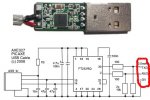I'm about to build myself a newer computer, and it won't have a serial port like the dinosaur I'm using now, so Ill obviously need a USB to Serial adapter to program my Picaxe uCs. As I already have all the components I need to build the AXE027 in the attached schematic. What I'm a little confused about is the TX and RX connections that I've circled in red, do they connect like "TX to TX" on the Picaxe (TX to Serial Out) and RX to RX (RX to Serial In), or does it mean the TX side on the AXE027 is transmitting data to the Picaxe, in which case the AXE027 TX would connect to the Serial IN side of the Picaxe. Which way is correct? One more question....will I be need to use a logic level converter with this device?



